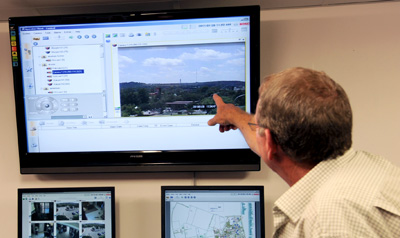 |
|
Mr Willie Frankim, Head of Protection Services at the UFS, in the new control room on the Main Campus.
- Photo: Dries Myburgh
|
The University of the Free State (UFS) officially launched its security control room recently. This new addition to the university's infrastructure, which was implemented in December 2010, has already made a contribution to the combating of crime at the UFS.
The decrease in crime statistics for January this year (5 cases), in comparison to the statistics of January 2010 (51 cases) is proof that the UFS’s new approach to combating crime on campus has an impact.
According to Prof. Niel Viljoen, Vice-Rector: Operations, the safety of students, lecturers and staff of the UFS is of the utmost importancet. For this reason, it is continuously reflected on about what can be done to improve the levels of safety for the respective campuses.
Apart from the upgraded security control room, from where, amongst others, residences, pedestrian routes, campus buildings, parking areas, entrances at gates and computer rooms at residences are observed, a number of measures have been set in place to improve the task of combating crime.
These measures include:
- Security cameras in front of all the women’s residences. The UFS is in the process of also installing
security cameras in front of the men’s residences.
- Shrubs and trees that caused obstruction in front of cameras have been pruned.
- Security officers patrol the pedestrian routes as well as the Red Square on foot from 06:00-22:00.
- A security officer has been appointed at each residence to be on duty from 18:00 to 06:00
at the residence.
- Two vehicles patrol the Main Campus on a 24-hour basis.
- The UFS is in die process to install alarms, which will be linked to the central security control room,
in all buildings.
- In certain buildings panic buttons have been installed in strategic places.
- Where possible, better entrance control to building, especially office blocks, has been implemented.
- Better management and integration of the security workers who are contracted from outside.
More security workers have also been appointed to do duty at each residence as well as on the
pedestrian routes (during the hours indicated).
- A survey has once again been done of all “dark spots” on the campus and better lighting is
currently being installed.
The reduced reaction times are a direct result of the operational process between security staff in the control room with met security staff that patrols the campus on foot and by vehicle
Media Release
09 February 2011
Issued by: Lacea Loader
Director: Strategic Communication (actg)
Tel: 051 401 2584
Cell: 083 645 2454
E-mail: news@ufs.ac.za